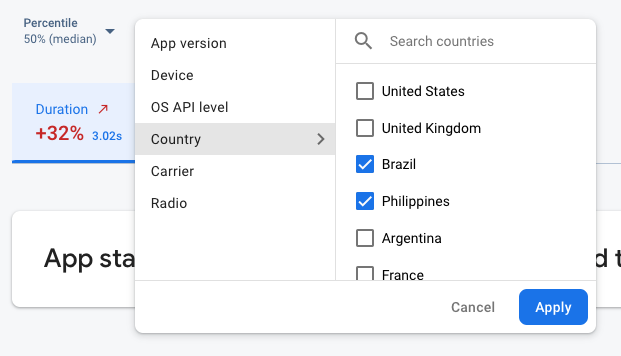בעזרת Performance Monitoring, אפשר להשתמש במאפיינים כדי לפלח את נתוני הביצועים ולהתמקד בביצועי האפליקציה בתרחישים שונים בעולם האמיתי.
אחרי שלוחצים על שם של מעקב בטבלת המעקבים (שנמצאת בתחתית מרכז הבקרה של הביצועים), אפשר להציג מדדים ספציפיים. משתמשים בלחצן
 נתונים ממעקב אחרי ביצועים ב-Firebase מסוננים לפי מאפיין" />
נתונים ממעקב אחרי ביצועים ב-Firebase מסוננים לפי מאפיין" />
- אפשר לסנן לפי גרסת האפליקציה כדי לראות נתונים על גרסה קודמת או על הגרסה האחרונה
- מסננים לפי מכשיר כדי לראות איך מכשירים ישנים יותר מטפלים באפליקציה
- מסננים לפי מדינה כדי לוודא שהמיקום של מסד הנתונים לא משפיע על אזור מסוים.
כדי לבצע ניתוח מפורט יותר על סמך מאפיינים, מייצאים את נתוני הביצועים ל-BigQuery.
מאפייני ברירת מחדל
Performance Monitoring אוסף באופן אוטומטי מגוון מאפייני ברירת מחדל בהתאם לסוג העקבות.
בנוסף למאפייני ברירת המחדל האלה, אפשר גם ליצור מאפיינים מותאמים אישית במעקבים של קוד מותאם אישית כדי לפלח את הנתונים לפי קטגוריות ספציפיות לאפליקציה. לדוגמה, במשחק אפשר לפלח את הנתונים לפי רמת המשחק.
מאפייני ברירת מחדל לאפליקציות ל-Apple ולאפליקציות ל-Android
כל העקבות של אפליקציות ל-Apple ול-Android אוספים את המאפיינים הבאים כברירת מחדל:
- גרסת אפליקציה
- מדינה
- רמת מערכת ההפעלה
- מכשיר
- רדיו
- ספק
בנוסף, מעקב אחר בקשות לרשת אוסף גם את המאפיין הבא:
- סוג MIME
איסוף נתוני משתמשים
יצירת מאפיינים מותאמים אישית
אפשר ליצור מאפיינים מותאמים אישית בכל אחד מהמעקבים של קוד בהתאמה אישית שמוגדרים באמצעות מכשור.
משתמשים ב-Trace API (Swift | Obj-C) כדי להוסיף מאפיינים מותאמים אישית למעקבים של קוד מותאם אישית.Performance Monitoring
כדי להשתמש במאפיינים מותאמים אישית, צריך להוסיף לאפליקציה קוד שמגדיר את המאפיין ומקשר אותו למעקב ספציפי של קוד מותאם אישית. אפשר להגדיר את המאפיין המותאם אישית בכל שלב בין תחילת המעקב לסיום המעקב.
שימו לב לנקודות הבאות:
השמות של מאפיינים מותאמים אישית צריכים לעמוד בדרישות הבאות:
- ללא רווחים מובילים או נגררים, ללא קו תחתון מוביל (
_) - אין מרחבים
- האורך המקסימלי הוא 32 תווים
- התווים המותרים בשם הם
A-Z,a-zו-_.
- ללא רווחים מובילים או נגררים, ללא קו תחתון מוביל (
כל מעקב אחר קוד בהתאמה אישית יכול לתעד עד 5 מאפיינים בהתאמה אישית.
חשוב לוודא שהמאפיינים המותאמים אישית לא מכילים מידע שמזהה באופן אישי אדם מסוים עבור Google.
מידע נוסף על ההנחיה הזו
Swift
let trace = Performance.startTrace(name: "CUSTOM_TRACE_NAME") trace.setValue("A", forAttribute: "experiment") // Update scenario. trace.setValue("B", forAttribute: "experiment") // Reading scenario. let experimentValue:String? = trace.valueForAttribute("experiment") // Delete scenario. trace.removeAttribute("experiment") // Read attributes. let attributes:[String, String] = trace.attributes;
Objective-C
FIRTrace *trace = [FIRPerformance startTraceWithName:@"CUSTOM_TRACE_NAME"]; [trace setValue:@"A" forAttribute:@"experiment"]; // Update scenario. [trace setValue:@"B" forAttribute:@"experiment"]; // Reading scenario. NSString *experimentValue = [trace valueForAttribute:@"experiment"]; // Delete scenario. [trace removeAttribute:@"experiment"]; // Read attributes. NSDictionary <NSString *, NSString *> *attributes = [trace attributes];

